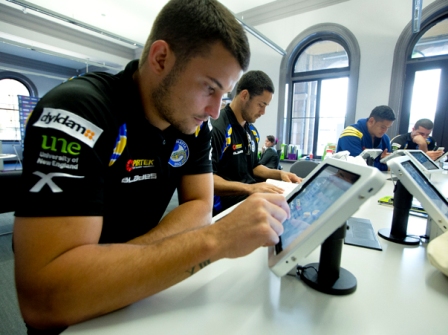School today isn’t the same as it used to be. As shocking as it might be to those of us who only used IT in designated classrooms called “computer labs” to hear that today’s students are not only using laptops in every class they take as early as elementary school, the proliferation of technology in the classroom is a much deeper rabbit hole. Education is jumping to the cloud, with Google (News  - Alert) Education fueled solutions like UGcloud in Southern Ontario schools, students no longer have the excuse of forgetting homework at home and teachers have better insight into work habits of their progeny. The biggest boon to educators, however, is also the most classically futuristic: video conferencing is changing the classroom in the ways we always hoped it would.
- Alert) Education fueled solutions like UGcloud in Southern Ontario schools, students no longer have the excuse of forgetting homework at home and teachers have better insight into work habits of their progeny. The biggest boon to educators, however, is also the most classically futuristic: video conferencing is changing the classroom in the ways we always hoped it would.
Using Skype (News  - Alert), members of the Pirtek Parramatta Eels, a rugby team, were able to use the well known VoIP service’s video capabilities to remotely enter the classrooms of local preschools and field questions from the kids they inspire. But video conferencing isn’t just about off-curriculum question and answer sessions – it has very practical uses, some of them obvious and others not as much.
- Alert), members of the Pirtek Parramatta Eels, a rugby team, were able to use the well known VoIP service’s video capabilities to remotely enter the classrooms of local preschools and field questions from the kids they inspire. But video conferencing isn’t just about off-curriculum question and answer sessions – it has very practical uses, some of them obvious and others not as much.

Pirtek Parramatta Eels rugby team members using video conferencing.
It’s not new. Video conferencing was being used to connect classrooms in 2009 to improve literacy through the Read Around The Planet (News - Alert) program. Using Polycom’s video conferencing, participating classrooms were matched with a counterpart from another state or country and had a super-quick and convenient exchange class based on predetermined material provided by the respective teachers.
Since then, VoIP technology has taken leaps and bounds in popularity, landing with video conferencing solutions in even more remote schools in Ghana. The possibilities with this kind of technology are limited only by the lesson plans that are transmitted over it. Imagine the possibilities of cultural studies, allowing students to learn about other places first hand by interacting with new friends their own age. The possibilities of studying abroad or in the field suddenly become more focused with the ability to constantly connect face to face with professors and peers alike. It appears that the only thing missing from the equation is complete accessibility.
Despite its obvious applications and maturity, video conferencing isn’t quite as ubiquitous as it ideally will be. Post-secondary schools are still catching up, as the kind of technology we’re talking about here is expensive when the massive student populations of colleges and universities are taken into account. In higher-education institutes video conferencing is gaining popularity in group research and projects. The service being leveraged in universities and colleges is Vidyo (News - Alert) through a partnership with Internet2 that is providing the service to over 220 affiliated institutions. It’s only a matter of time until video conferencing becomes as much a staple of the classroom as the blackboard once was.
Edited by Alisen Downey
 Internet Telephony Magazine
Click here to read latest issue
Internet Telephony Magazine
Click here to read latest issue CUSTOMER
CUSTOMER  Cloud Computing Magazine
Click here to read latest issue
Cloud Computing Magazine
Click here to read latest issue IoT EVOLUTION MAGAZINE
IoT EVOLUTION MAGAZINE




